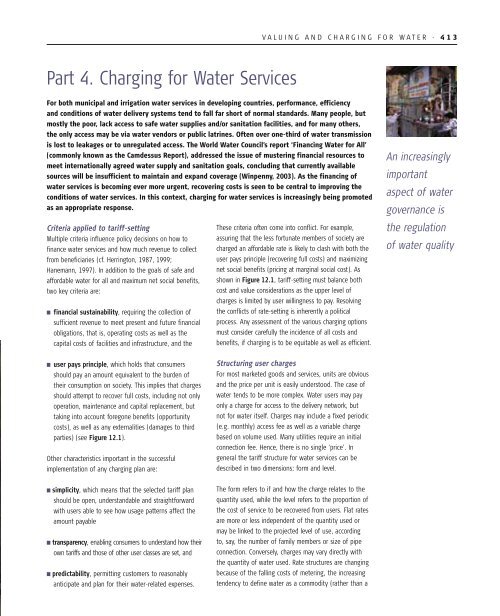Water: a shared responsibility; 2006 - UN-Water
Water: a shared responsibility; 2006 - UN-Water
Water: a shared responsibility; 2006 - UN-Water
You also want an ePaper? Increase the reach of your titles
YUMPU automatically turns print PDFs into web optimized ePapers that Google loves.
V A L U I N G A N D C H A R G I N G F O R W A T E R . 413<br />
Part 4. Charging for <strong>Water</strong> Services<br />
For both municipal and irrigation water services in developing countries, performance, efficiency<br />
and conditions of water delivery systems tend to fall far short of normal standards. Many people, but<br />
mostly the poor, lack access to safe water supplies and/or sanitation facilities, and for many others,<br />
the only access may be via water vendors or public latrines. Often over one-third of water transmission<br />
is lost to leakages or to unregulated access. The World <strong>Water</strong> Council’s report ‘Financing <strong>Water</strong> for All’<br />
(commonly known as the Camdessus Report), addressed the issue of mustering financial resources to<br />
meet internationally agreed water supply and sanitation goals, concluding that currently available<br />
sources will be insufficient to maintain and expand coverage (Winpenny, 2003). As the financing of<br />
water services is becoming ever more urgent, recovering costs is seen to be central to improving the<br />
conditions of water services. In this context, charging for water services is increasingly being promoted<br />
as an appropriate response.<br />
Criteria applied to tariff-setting<br />
Multiple criteria influence policy decisions on how to<br />
finance water services and how much revenue to collect<br />
from beneficiaries (cf. Herrington, 1987, 1999;<br />
Hanemann, 1997). In addition to the goals of safe and<br />
affordable water for all and maximum net social benefits,<br />
two key criteria are:<br />
■ financial sustainability, requiring the collection of<br />
sufficient revenue to meet present and future financial<br />
obligations, that is, operating costs as well as the<br />
capital costs of facilities and infrastructure, and the<br />
These criteria often come into conflict. For example,<br />
assuring that the less fortunate members of society are<br />
charged an affordable rate is likely to clash with both the<br />
user pays principle (recovering full costs) and maximizing<br />
net social benefits (pricing at marginal social cost). As<br />
shown in Figure 12.1, tariff-setting must balance both<br />
cost and value considerations as the upper level of<br />
charges is limited by user willingness to pay. Resolving<br />
the conflicts of rate-setting is inherently a political<br />
process. Any assessment of the various charging options<br />
must consider carefully the incidence of all costs and<br />
benefits, if charging is to be equitable as well as efficient.<br />
An increasingly<br />
important<br />
aspect of water<br />
governance is<br />
the regulation<br />
of water quality<br />
■ user pays principle, which holds that consumers<br />
should pay an amount equivalent to the burden of<br />
their consumption on society. This implies that charges<br />
should attempt to recover full costs, including not only<br />
operation, maintenance and capital replacement, but<br />
taking into account foregone benefits (opportunity<br />
costs), as well as any externalities (damages to third<br />
parties) (see Figure 12.1).<br />
Other characteristics important in the successful<br />
implementation of any charging plan are:<br />
■ simplicity, which means that the selected tariff plan<br />
should be open, understandable and straightforward<br />
with users able to see how usage patterns affect the<br />
amount payable<br />
■ transparency, enabling consumers to understand how their<br />
own tariffs and those of other user classes are set, and<br />
■ predictability, permitting customers to reasonably<br />
anticipate and plan for their water-related expenses.<br />
Structuring user charges<br />
For most marketed goods and services, units are obvious<br />
and the price per unit is easily understood. The case of<br />
water tends to be more complex. <strong>Water</strong> users may pay<br />
only a charge for access to the delivery network, but<br />
not for water itself. Charges may include a fixed periodic<br />
(e.g. monthly) access fee as well as a variable charge<br />
based on volume used. Many utilities require an initial<br />
connection fee. Hence, there is no single ‘price’. In<br />
general the tariff structure for water services can be<br />
described in two dimensions: form and level.<br />
The form refers to if and how the charge relates to the<br />
quantity used, while the level refers to the proportion of<br />
the cost of service to be recovered from users. Flat rates<br />
are more or less independent of the quantity used or<br />
may be linked to the projected level of use, according<br />
to, say, the number of family members or size of pipe<br />
connection. Conversely, charges may vary directly with<br />
the quantity of water used. Rate structures are changing<br />
because of the falling costs of metering, the increasing<br />
tendency to define water as a commodity (rather than a
















